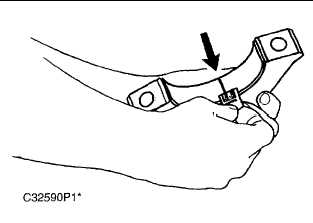TM 5-3895-383-24
1.
The serviceman must be very careful to use Plastigage
correctly. The following points must be remembered:
a.
Be sure that the backs of the bearings and the bores
are clean and dry.
b.
The bearing locking tabs must be properly seated in
their slots.
c.
The crankshaft must be free of oil where it is in
contact with the Plastigage.
d.
If the main bearing clearances are checked with the
engine upright or on is side, the crankshaft must be
supported. Use a jack under an adjacent crankshaft
counterweight, and hold the crankshaft against the
crown of the bearing. If the crankshaft is not
supported, the weight of the crankshaft will cause
incorrect readings.
e.
Put a piece of Plastigage on the crown of the bearing
half that is in the cap. Do not allow the Plastigage to
extend over the edge of the bearing.
f.
Install the bearing cap using the correct torque-turn
specifications. Do not use an impact wrench to
tighten the bearing cap mounting bolts. Be careful not
to dislodge the bearing when the cap is installed.
g.
Do not turn the crankshaft with the Plastigage
installed.
NOTE:
When using Plastigage to measure bearing
clearances, the readings can sometimes be
unclear. For example, all parts of the Plastigage
are not the same width. Measure the major width
to be sure they are within specification range.
h.
Carefully remove the bearing cap, but do not remove
the Plastigage. Measure the width of the Plastigage
while it is in the bearing cap or on the crankshaft
journal. See the photograph which illustrates this.
i.
Remove all Plastigage before reinstalling the bearing
cap.
8-59/(8-60 blank)

